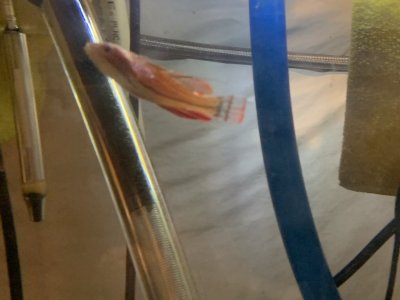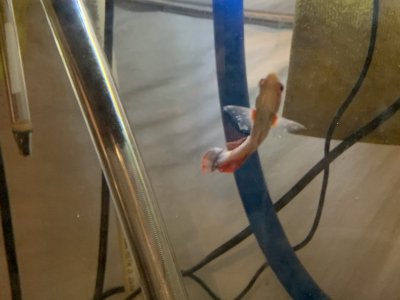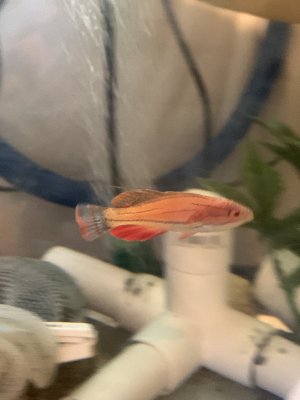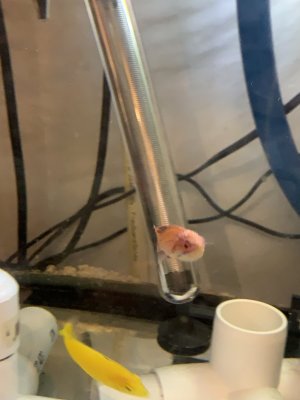Navigation
Install the app
How to install the app on iOS
Follow along with the video below to see how to install our site as a web app on your home screen.
Note: This feature may not be available in some browsers.
More options
You are using an out of date browser. It may not display this or other websites correctly.
You should upgrade or use an alternative browser.
You should upgrade or use an alternative browser.
Struggling wrasse in QT
- EMERGENCY
- Thread starter FortyFour44
- Start date
- Tagged users None
My concern is regarding the species of fluke your fish have. Prazipro is not very effective against one of the main ones, Neobenedenia. Additionally, treating a tank multiple times with prazi results in a population of bacteria that actually feed on the drug - then you are just adding it to the tank and having the bacteria take it right back out again.Thanks. I agree on metro. Should I freshwater dip the other 2 to check for visual signs of flukes? Another round of Prazi? In what order?
Stressful part of the hobby!
A properly done FW dip on the remaining two wrasse would give you information about the presence of flukes, and if they have flukes, it will buy you a little time. Neobenedenia can be identified by just looking at it in many cases, but a small hand lens would help.
Jay Hemdal
My concern is regarding the species of fluke your fish have. Prazipro is not very effective against one of the main ones, Neobenedenia. Additionally, treating a tank multiple times with prazi results in a population of bacteria that actually feed on the drug - then you are just adding it to the tank and having the bacteria take it right back out again.
A properly done FW dip on the remaining two wrasse would give you information about the presence of flukes, and if they have flukes, it will buy you a little time. Neobenedenia can be identified by just looking at it in many cases, but a small hand lens would help.
Jay Hemdal
Thank you Jay. Would a different prazi medication be more effective against that type of fluke?
Also, last night I noticed the McCoskers has white spots. I thought it was ick, but was doing reading last night and it might actually be velvet. I’ve never dealt with that and know there is good reading on it. I know I have to act quickly. Is there a certain type of copper I should have since I have 2 cooper sensitive species? I also have malachite green/methylene blue on hand. Would either be useful in buying me time?
Last edited:
Thank you Jay. Would a different prazi medication be more effective against that type of fluke?
Also, last night I noticed the McCoskers has white spots. I thought it was ick, but was doing reading last night and it might actually be velvet. I’ve never dealt with that and know there is good reading on it. I know I have to act quickly. Is there a certain type of copper I should have since I have 2 cooper sensitive species? I also have malachite green/methylene blue on hand. Would either be useful in buying me time?
No - all prazi medications have the same active ingredient, Prazipro is very effective - just not for Neo.
How many white spots does the McCosker's have? Velvet, (Amyloodinium) typically shows smaller, or no spots (as the infection starts in the gills). The first symptom is rapid breathing, followed by anorexia. It is very swift to kill. Some people have reported success with acriflavine, but I have not tried that myself. An amine-complexed copper would work o.k. - Cupramine for example, or Coppersafe. Trouble is, those take time to effect a cure, and while you have time if it is Cryptocaryon (ich) you may not for velvet. Here is an excerpt on velvet from my upcoming book:
Amyloodinium (a.k.a. marine velvet disease)
Cause
Commonly known as “marine velvet” in hobby parlance, Amyloodinium is caused by a dinoflagellate protozoan that can produce severe epidemics in aquariums. Furthermore, it can infect fishes that are normally more resistant to other marine protozoan diseases (e.g., Cryptocaryon), such as sharks, rays, and eels.
Symptoms
The life cycle of Amyloodinium is very similar to that of Cryptocaryon, as are the possible treatments available, but it has less distinctive early symptoms and can cause fish mortalities much sooner than other protozoan infections—sometimes within 12 hours of the onset of obvious symptoms. This disease begins as an infection of the fish’s gills, and only in advanced cases does it spread to the skin, giving it a “velvety” look.
Beginning aquarists often miss the first symptoms and commonly report, “All my fish suddenly died, but the invertebrates are all fine.” Since invertebrates are typically more sensitive to water-quality issues than fish are, the fact that the fish suddenly died but the invertebrates were unharmed means that water-quality problems can be ruled out. That leaves a fish disease, and Amyloodinium can often be diagnosed without even needing to perform a necropsy on the fish due to the rapidity of the fish loss!
Diagnosis
The key to early diagnosis of Amyloodinium is to monitor the fish’s gill health by taking regular fish respiration rates. This is a simple matter of counting the number of gill beats in one minute for a representative fish in the aquarium and then rechecking the respiration rate every few days to watch for any elevation in that rate.
Newly acquired fish that are not being treated prophylactically should have their respiration rate checked daily, as these fish are the ones at greatest risk of developing this disease. The actual respiration rate is not that important, it is a rise in the rate that must be monitored for.
Different species of fish will respire at different rates. Smaller fish breathe faster than large ones, and fish in warmer water will respire faster as well. Typically, tropical fish will respire between 60 and 120 gill beats per minute. If you can’t view the fish for a full minute, you can try counting for 15 seconds and multiplying the result by four.
Knowing your fish’s normal baseline respiration rate is vital; any rise in that rate above 30% (and not attributable to something else, such as the fish being chased by a tankmate) should be viewed as a possible symptom of this disease.
Treatment
Treatments for Amyloodinium cannot be performed with invertebrates present, yet the entire tank usually needs to be treated in order to eradicate it. Copper sulfate at 0.20 ppm for 14 days is one often-used cure. Chloroquine at 8 to 15 ppm as a 30-day static bath is another treatment that has been used with good success.
Performing freshwater dips or lowering the tank’s temperature is rarely effective. Likewise, hyposalinity treatments (sometimes recommended for Cryptocaryon treatments) will not work for Amyloodinium.
Jay
This might sound crazy but a vast majority of the spots are gone today and the McCoskers seems to be doing well. What gives?
One thing to watch out for - when Cryptocaryon first gets started, the few parasites are all about the same age, so they mature and drop off the fish at around the same time. This gives false hope because the fish looks clean, but then the tomites from those parasites swarm and attach to the fish and the spots return, in even higher numbers. Eventually, the ich becomes out of sync and the fish has spots all the time.
I'm not saying that this is what happened here - just be aware. There are also cases of idiopathic white spots (from no real cause) and those can just go away on their own and stay gone.....
Jay
I'm not saying that this is what happened here - just be aware. There are also cases of idiopathic white spots (from no real cause) and those can just go away on their own and stay gone.....
Jay
One thing to watch out for - when Cryptocaryon first gets started, the few parasites are all about the same age, so they mature and drop off the fish at around the same time. This gives false hope because the fish looks clean, but then the tomites from those parasites swarm and attach to the fish and the spots return, in even higher numbers. Eventually, the ich becomes out of sync and the fish has spots all the time.
I'm not saying that this is what happened here - just be aware. There are also cases of idiopathic white spots (from no real cause) and those can just go away on their own and stay gone.....
Jay
I really appreciate this. Does this mean it is more likely to be ich than velvet?
Ich is certainly more commonly seen. I just can't tell from the photos. Velvet is very swift to kill, so based on that, I think I would consider ruling that out.
Jay
Jay
Can a freshwater dip reveal anything other than flukes? After 5 min, I see one fluke but more of what looks like tiny copepods. The McCoskers has what looked like phlegm coming from its gills.
Backstory:
Preparing to use Coopersafe to battle what I’m almost sure is ich (McCoskers) but wanted to FW dip it first (along with yellow coris) after the dead solarensis was covered after 2 rounds of prazi.
Backstory:
Preparing to use Coopersafe to battle what I’m almost sure is ich (McCoskers) but wanted to FW dip it first (along with yellow coris) after the dead solarensis was covered after 2 rounds of prazi.
Copepods do show up in dips, but small, obligate copepod parasites are rare...more often, they are just normal pods that got caught in the net while you caught the fish out, and are not parasitic. Still, I can’t rule it out. I don’t suppose you have a microscope or a magnifying lens? JayCan a freshwater dip reveal anything other than flukes? After 5 min, I see one fluke but more of what looks like tiny copepods. The McCoskers has what looked like phlegm coming from its gills.
Backstory:
Preparing to use Coopersafe to battle what I’m almost sure is ick (McCoskers) but wanted to FW dip it first (along with yellow coris) after the dead solarensis was covered after 2 rounds of prazi.
I do not have a magnifying lens handy at the moment.
Whatever it is (if anything at all) is it safe to say that the coppersafe + general cure will clear it up? I’m going down that path anyways.
Whatever it is (if anything at all) is it safe to say that the coppersafe + general cure will clear it up? I’m going down that path anyways.
A freshwater dip can alleviate some of the symptoms of a velvet infestation, buying you some time to act.
I ended up with Velvet myself a few months ago. I used coppersafe and my cleaner wrasse made it through without issue, at least until it went carpet surfing.
Copper should be ramped up over a couple of days, especially with sensitive species. Can do a FW dip every other day or so until you're at the therapeutic dose. They won't like it, but it's better than death. Velvet can kill really fast, in mere days. You won't see anything come off the fish as they are microscopic.
Tank Transfer is also a viable option, but with 36 hour transfers, you should have 3 tanks or bins to allow ample time for drying between transfers. I have a Hippo going through it right now for ich. Definitely not the happiest tang in the world, but the spots went away immediately, and it's eating.
I ended up with Velvet myself a few months ago. I used coppersafe and my cleaner wrasse made it through without issue, at least until it went carpet surfing.
Copper should be ramped up over a couple of days, especially with sensitive species. Can do a FW dip every other day or so until you're at the therapeutic dose. They won't like it, but it's better than death. Velvet can kill really fast, in mere days. You won't see anything come off the fish as they are microscopic.
Tank Transfer is also a viable option, but with 36 hour transfers, you should have 3 tanks or bins to allow ample time for drying between transfers. I have a Hippo going through it right now for ich. Definitely not the happiest tang in the world, but the spots went away immediately, and it's eating.
Ordering ceramic rings to replace the existing marinepure biofilter and minimize copper absorption.
Replacing large air stone with disposable ones (reduce absorption).
Since Amazon delivery will take a few days anyways, will swap coppersafe with copper power.
Will raise salinity from 1.022 to 1.026 to match my FSW and make water changes easier if needed.
Replacing large air stone with disposable ones (reduce absorption).
Since Amazon delivery will take a few days anyways, will swap coppersafe with copper power.
Will raise salinity from 1.022 to 1.026 to match my FSW and make water changes easier if needed.
Copepods do show up in dips, but small, obligate copepod parasites are rare...more often, they are just normal pods that got caught in the net while you caught the fish out, and are not parasitic. Still, I can’t rule it out. I don’t suppose you have a microscope or a magnifying lens? Jay
Can someone please help me ID this on my McCoskers? Was fairly certain it has ich (preparing copper treatment. This obviously looks like something different like a bacterial infection and hopefully not something worse.
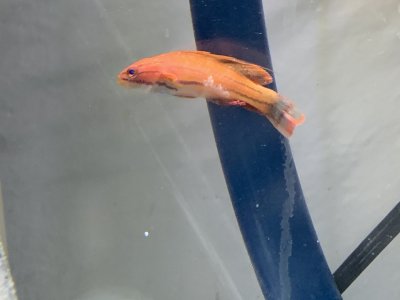
Many issues are difficult to identify from a picture. At a public aquarium, they would carefully take a biopsy (scrape) of that lesion and look at it under a microscope to determine if it is bacterial or protozoan in origin. They might even do gram staining or a sensitivity test if bacterial.
That said, if the fish is still feeding, I would proceed with the copper treatment, and possibly introduce a broad spectrum antibiotic. Furan-2 or Kanaplex perhaps?
Jay
Many issues are difficult to identify from a picture. At a public aquarium, they would carefully take a biopsy (scrape) of that lesion and look at it under a microscope to determine if it is bacterial or protozoan in origin. They might even do gram staining or a sensitivity test if bacterial.
That said, if the fish is still feeding, I would proceed with the copper treatment, and possibly introduce a broad spectrum antibiotic. Furan-2 or Kanaplex perhaps?
Jay
Thanks. I have kana on hand. Should I soak the food or do a broadcast treatment? During Cooper treatment?
Many issues are difficult to identify from a picture. At a public aquarium, they would carefully take a biopsy (scrape) of that lesion and look at it under a microscope to determine if it is bacterial or protozoan in origin. They might even do gram staining or a sensitivity test if bacterial.
That said, if the fish is still feeding, I would proceed with the copper treatment, and possibly introduce a broad spectrum antibiotic. Furan-2 or Kanaplex perhaps?
Jay
Is this a better picture?
Moved forward with the kana broadcast, as I haven’t been able to get it to eat yet.
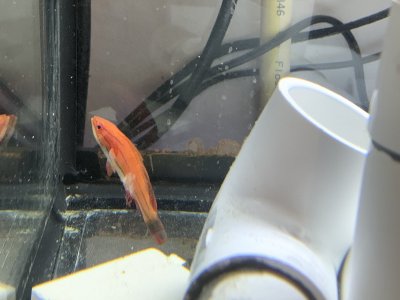
McCoskers died. No signs of flukes. One wrasse left. A very healthy, hearty looking yellow coris. As much as I just want to put it into the display and save it from chemical treatment, I don’t think I will. I have copper power on hand, and general cure on the way. Given how the last 2 wrasses went down, I feel I’m in this one for the long haul.
My LFS keeps its fish in therapeutic levels of copper. Pretty sure the McCoskers had ick.
QT is so frustrating. Had a McCoskers make it through only to jump a couple days later. 0 for 3 with McCoskers now.
Similar threads
- Replies
- 4
- Views
- 181
- Replies
- 12
- Views
- 254
- Replies
- 7
- Views
- 260
- Replies
- 27
- Views
- 344




